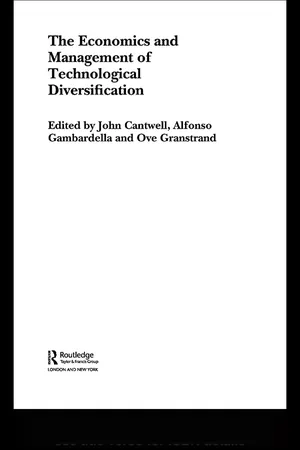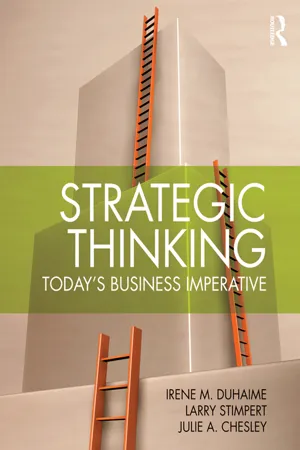Business
Diversification
Diversification refers to the strategy of expanding a company's product or service offerings into new markets or industries. This approach aims to reduce risk by not relying solely on one product or market. By diversifying, businesses can potentially increase their revenue streams and protect themselves from downturns in specific sectors.
Written by Perlego with AI-assistance
Related key terms
Related key terms
1 of 4
Related key terms
1 of 3
8 Key excerpts on "Diversification"
- eBook - ePub
The Growth Strategies of Hotel Chains
Best Business Practices by Leading Companies
- Kaye Sung Chon(Author)
- 2006(Publication Date)
- Routledge(Publisher)
If, as a starting point, Ansoff’s famous growth vector matrix (1976) is accepted, two forms of growth are possible: expansion and Diversification. Diversification occurs only when a company attempts to grow by introducing a new product to a new market, i.e., fulfilling a new mission. It therefore means the incorporation of a new productmarket pair or of an activity or activities different from the existing one(s). In contrast, expansion is the result of market penetration (intensifying efforts to increase the company’s share of its existing products in the existing market), market development (seeking new markets for the company’s existing products), or product development (offering new products to the existing markets).During the development of this new activity additional factors will be involved that hold the keys to success, together with a different competitive environment. This requires knowledge and the development of a new field of business with the resulting need for more skills.Remember that in response to the demands of a more complex reality Ansoff (1976) perfected his growth vector by situating it in a three-dimensional space. Thus executives can expand their companies by penetrating new geographic markets, meeting new market needs, or introducing new technologies in such a way that multiple strategic combinations and approaches are open to them, from continuing to meet the traditional needs of their usual markets with traditional technology to making an energetic bid to reposition themselves in the three dimensions.This definition of the nature of Diversification helps us to understand that when a company executive decides to diversify, his or her success depends not only on the potential growth and profitability of the new business activity, but also (and above all) on the company’s capacity to develop whatever new skills are required for this activity and even for this new field of business. This reveals the expansion- or specialization-related difficulties that Diversification entails. Perhaps a company should diversify only when it cannot expand by specialization (Strategor, 1988). - Cheng-Few Lee, Min-Teh Yu, Cheng Few Lee, Min-Teh Yu(Authors)
- 2018(Publication Date)
- Emerald Publishing Limited(Publisher)
For example, through diversifying into different industrial segments, the firms face greater uncertainties, for the possibility of suffering various industry-specific risks has increased. Also, Diversification is able to reduce the efficiency of managing various business divisions due to less focus put on each division if compared to managing single business activity only (Hill & Hoskisson, 1987). This could constitute to the lowering of the productivity of the core business (Gomes & Livdan, 2004), hence, decrease the strength of competition of the core business in the market. It has given a greater discount with Diversification. A group of scholars finds that the nature of each diversified segment should be concerned when studying Diversification. Previous studies of Rumelt (1974, 1982) have classified various Diversification strategies, i.e., dominant vertical Diversification, dominant constrained Diversification, dominant linked-unrelated Diversification, related constrained Diversification, related link Diversification, and unrelated business Diversification. The classification is based on the fraction of revenues accounted for by its core business unit. The other studies such as Lubatkin and O’Neil (1987), Bettis and Hall (1982), and Montgomery and Singh (1984) also classify Diversification by different strategies- John Cantwell, Alfonso Gambardella, Ove Granstrand(Authors)
- 2004(Publication Date)
- Routledge(Publisher)
Generally speaking “Diversification” can be taken to mean the degree of spread the range of activities or outcomes of activities A associated with some organized unit B. Thus, in this book by Diversification we mean the level of the breadth or spread of some dispersed activities, and not the process by which that dispersion might be extended, which in our terms would amount to an increase (a change) in the Diversification of activities or outcomes A. In the context here, B can be a company, industry, nation or region as well as an individual or a collection of individuals, while A can refer to a set of portfolio of products, applications or markets, or resources like technologies, competencies, or labor skills. Usually the elements in the set A are classified or categorized according to some taxonomy (typology, decomposition, disaggregation) and extending the range means including from one point in time to another new elements of a new type (class, category) not covered at the previous point in time. Thus, the concept of Diversification and its measurement depends upon the choice of classification and points in time considered. What makes the definition somewhat ambiguous is that an increase in Diversification may also occur if diversity is increased, which may happen even without any extension of the range, depending upon how diversity (variety, dispersion, heterogeneity) is measured, as explained further below. Essentially we have a definite, discrete distribution of elements in a number of classes and a possibly multi-dimensional diversity measure defined on the set of such distributions, and such a measure could very well increase without including elements of new types. Besides numerous diversity measures are conceivable.1.5.2 Types of Diversification
From the point of view of a firm a number of types of Diversification can now be defined. Traditionally Diversification has referred to the range and distribution of outputs of the firm, classified in terms of products, (output) markets or businesses. Here we complement these types of output Diversification with different types of input Diversification or resource Diversification. These latter types refer to the range and distribution of inputs (factors, resources) of the firm, classified not only in terms of raw materials, physical capital, and financial assets but also in terms of technologies, knowledge, competences, IPRs, network relationships and other forms of intangible inputs (resources, assets, capital). In particular, we will focus in this survey on technological Diversification, which is then liable to increase as the diversity of technologies is increased. Technologies are usually taken to mean bodies of technical knowledge, thus making technological Diversification a special case of knowledge Diversification (or competence Diversification). Thus, in the evolution of a multiproduct, multifactor firm, Diversification takes place both in product space and in resource space, giving rise to Diversification trajectories in these spaces. If the original range (set of types of products or factors) remains unchanged, then Diversification is (product or factor) rooted, otherwise it is floating. The direction of Diversification- eBook - ePub
Corporate Level Strategy
Theory and Applications
- Olivier Furrer(Author)
- 2016(Publication Date)
- Routledge(Publisher)
Chapter 5 Diversification Strategies Creating Corporate ValueDOI: 10.4324/9781315855578-5Diversification into new business areas can be economically justified only if it leads to value creation. Therefore, the mere existence of economies of scope is a necessary but not a sufficient condition for Diversification to be economically valuable (Barney, 2007 ). Rather, economic value derives from economies of scope that both exist and are less costly to realize within the boundaries of the firm than they would be through alternative forms of governance, such as market transactions or strategic alliances (Teece, 1980 ; Williamson, 1975 , 1985 ; Ye et al., 2012 ).For example, a diversified firm might create value by spreading its risk across multiple businesses. Most of the time, cash flows from different businesses do not correlate perfectly, so the riskiness of the cash flows of diversified firms should be lower than that of single business firms (for a demonstration, see Barney, 2007 ). Yet even if a firm reduces its overall risk by engaging in a portfolio of businesses, these risk reducing strategies are not necessarily valuable to the firm’s outside investors or shareholders, who tend to have their own, lower cost ways to reduce their risk (Chang & Thomas, 1989 ; Williamson, 1975 ). For example, they could invest directly through the stock market in their own diversified portfolio; doing so usually is much less costly than conceiving and implementing a corporate Diversification strategy. Moreover, most investors modify their portfolios easily and cheaply by buying or selling stocks. In contrast, modifying a firm’s portfolio of businesses, through M&A, internal development, or other means (see Chapters 10 and 11 ), tends to be far more costly. For these reasons, outside investors generally prefer to diversify their own portfolios to reduce risk by themselves rather than have managers diversify for them (Jensen, 1968 ; Jensen & Meckling, 1976 ). Empirical research in several industries also suggests that when firms pursue Diversification strategies solely to reduce shareholders’ risk, the strategies actually harm the economic performance of these firms on average (e.g., Amit & Livnat, 1988a ; Hill & Hansen, 1991 ). However, as shown in Box 5.1 - eBook - ePub
- Irene M. Duhaime, Larry Stimpert, Julie Chesley(Authors)
- 2012(Publication Date)
- Routledge(Publisher)
Evidence supplied by Cynthia Montgomery of the Harvard Business School shows that the level of Diversification among the 500 largest public companies in the United States actually increased in recent years. 55 Furthermore, there are many good reasons to believe that Diversification will continue to be an important feature of the economic landscape. Extensions of existing product lines, exploitation of economies of scale and scope, and expansion into new geographical areas remain compelling reasons for firms to move into new markets or to pursue new business opportunities. Firms will also continue to diversify into new businesses to reduce their reliance on declining business lines or industries. Given the dynamic nature of the economy, we can expect that firms will seize opportunities resulting from demographic shifts, the development of new products and services, and the emergence of new technologies, to diversify into new arenas. Much of the de-Diversification and restructuring activity that has occurred over the last two decades can be explained by the failure of these firms to develop effective understandings of how their businesses were related or fit together and how to manage those interrelationships effectively. Sears’ grand strategy for developing a consumer retailing powerhouse based on its merchandising, insurance, real estate, and financial services businesses failed because the company was never able to realize the anticipated synergies. Furthermore, Sears’ Diversification activities had a devastating impact on the company’s merchandising operations as managers “took their eye off the ball,” and lost sight of the need for Sears’ stores to maintain a strong and effective business definition in the ever-changing retail marketplace. 56 In addition, as noted in Chapter 9, many companies are restructuring their operations to emphasize those value-chain activities that contribute to their competitive advantage while outsourcing other, less critical activities - eBook - ePub
- P. Earl, Kenneth A. Loparo(Authors)
- 2014(Publication Date)
- Palgrave Macmillan(Publisher)
Put simply, a firm that invests a billion dollars in a single sector runs the risk of losing most of the money (more, if it is not even possible to cover its operating costs) if it is hit by an unforeseeable event that is fatal to that line of business. By contrast, if it invests $100 million in each of ten different lines of business it may have a good chance that many of its investments will run their course rather than being wiped out by unforeseeable events before they have delivered a satisfactory rate of return. Diversification drastically reduces focus losses where there is the possibility of unforeseeable catastrophic changes in the firm’s business environment, though focus gains may also be reduced somewhat by the firm having to forgo economies of scale or scope in its efforts to reduce its vulnerability by hedging its bets.The profits that a large innovating firm sacrifices by offering a wide range of products could actually be rather less than Kay’s analysis might lead one to suspect. For one thing, although it may work with a variety of technologies rather than concentrating in a single area, it may develop further new products by combining elements from existing ones, consistent with Shackle’s (1979, p. 24) view of how imaginative processes operate (see further, Earl, 2003; Earl and Wakeley, 2005, pp. 356–67). Such a firm can also afford to be much more imaginative with less need to be inhibited by the fear that boldness could wipe out the entire organization if it fails to work out as hoped. If there is the prospect that, over the long run, a team can enjoy a big enough set of successes to offset the projects that go way over budget during development or fail in the market, then decisions that would be ‘crucial’ in Shackle’s sense if they were being taken by undiversified firms can be taken with far less trepidation. A firm such as Sony may thus be bold in the battles it chooses to fight so long as it wins enough of them and can hold new competition at bay for long enough to earn high profits on its winning products. Sony lost the standards battle over videotape recording and its Minidiscs sold poorly against recordable compact discs outside of Japan, but for a time it enjoyed great success with its Walkman and via compact discs (jointly developed with Philips) and won the standards battle for high-definition video with its Blu-Ray technology. However, from a Shackleian standpoint, Sony’s wide range of products makes it hard to see the firm as particularly heroic, in contrast to, say, the glassmakers Pilkington Brothers, the firm that worked out a commercially viable float-glass manufacturing process: at the time, the latter was a family business and its bankers viewed the project as too risky, so the family fortune was put at stake to fund it. - eBook - ePub
- John Bridge, J. C. Dodds(Authors)
- 2018(Publication Date)
- Routledge(Publisher)
4 The Diversification Process 4.1 Forms of Development and Diversification The Diversification of the product line is seen by Marris as the prime means by which growth in demand is sustained. In fact Diversification may involve changes in the relationship between the firm and its markets as well as changes involving the product line itself. The firm’s choice of strategies can be represented in two dimensions. First, in H.I. Ansoff’s (9, 10) terminology, is the classification according to ‘product mission’ which is a description of the job which the product is supposed to perform. Second is the product line which can be described in terms of the physical attributes of the products and their performance characteristics. Ansoff prefers to use the concept of a mission rather than that of a customer since the latter has many different needs to be satisfied, each of which may require a different product. Businesses can achieve growth without Diversification, using market penetration, market development and product development strategies. Market penetration is brought about through increasing the volume of sales to the firm’s present customers, or by finding new customers with the same mission requirement. Market development involves the seeking of new mission requirements which can be served by the present production line, albeit frequently with some minor modifications in the products’ characteristics. Product development is an attempt to improve the performance of the mission by introducing new characteristics to the product line, but without seeking to serve a different mission - eBook - ePub
How to Develop a Strategic Marketing Plan
A Step-By-Step Guide
- Norton Paley(Author)
- 2017(Publication Date)
- Routledge(Publisher)
Procter & Gamble and Borden are experts in horizontal Diversification. Originally a soap company, Procter & Gamble has long since expanded horizontally into such diverse products as cake mixes, potato chips, coffee, paper products, toothpastes, deodorants, and detergents. Borden's product mix ranges from American cheese and reconstituted lemon juice to glue and adhesive tape.What these companies have discovered is that great economies can be derived from using the same sales force to sell new product categories to the same retail outlets, simply by applying already developed marketing skills. Because it involves building on an existing strength, either in technology or in marketing, horizontal Diversification is the most promising and least risky of the market Diversification strategies.Vertical Diversification
Hart Schaffner & Marx, the manufacturer of such famous clothing brands as Hickey-Freeman and Christian Dior, acquired a chain of retail stores in the early 1980s to add to its existing stores. This type of vertical Diversification has attracted a variety of companies.Some large retailers that produce some of the goods they sell practice another form of vertical Diversification. For instance, Sears makes some of its own appliances, or has large ownership interests in manufacturers. A&P makes much of its own baked goods. In the industrial sector, Ford has long owned its steel-making facilities.Vertical Diversification (or integration) in some instances increases the level of risk because the management of one level of business (retailing) may not have enough expertise at another level (manufacturing).Lateral Diversification
Lateral Diversification is the most extreme form of Diversification because it usually represents a complete departure from current operations. The only connection is that the same parent owns diverse businesses. The resulting group is called a conglomerate and was made popular in the 1960s by such corporate names as LingTemco-Vought, ITT Corporation, Litton Industries, Inc., and Gulf + Western, Inc.
Index pages curate the most relevant extracts from our library of academic textbooks. They’ve been created using an in-house natural language model (NLM), each adding context and meaning to key research topics.
Explore more topic indexes
Explore more topic indexes
1 of 6
Explore more topic indexes
1 of 4







